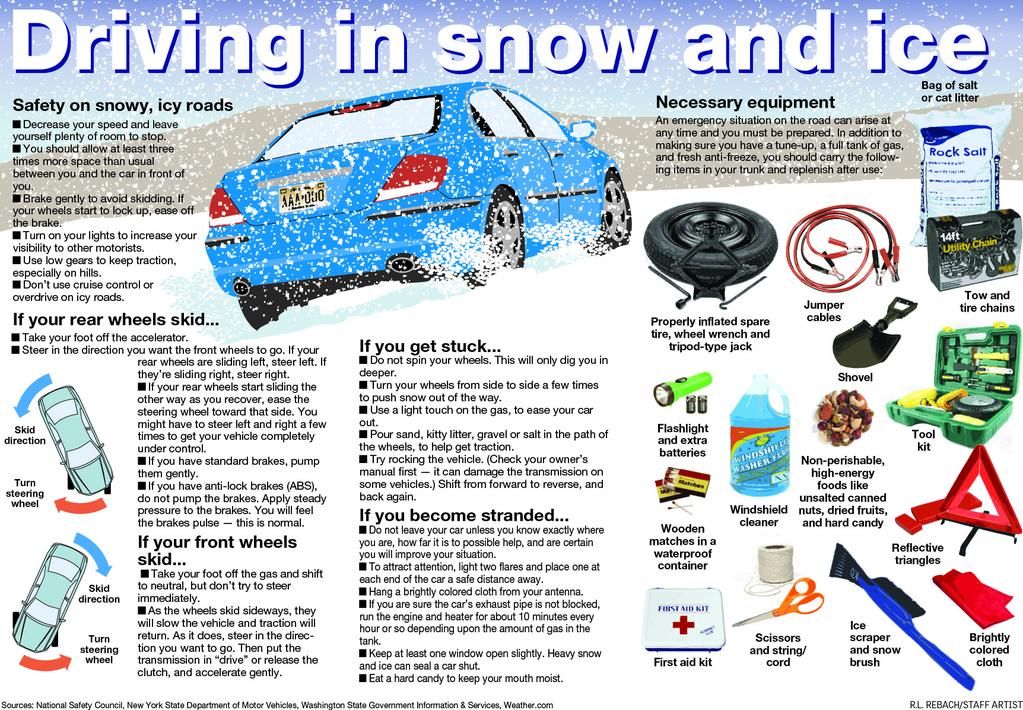A sturdy set of tire chains is something every vehicle owner should consider carrying along during the winter months. Some states require drivers to have them on hand in case weather makes roads difficult or dangerous for driving. Tire chains bite into heavy snow, slush, and ice to give your rig extra traction and help ensure safe arrival at your destination.
Tire chains are available for many different tire sizes and specific travel needs. Be sure to check your vehicle’s instruction manual for recommendations regarding the use of snow chains.
Know your tire size
One tire chain may fit multiple tire sizes. To figure out your tire size, locate the letter/number combination on the tire’s sidewall. The first three-digit number refers to the tire width in millimeters (measured from one sidewall to the other). The two-digit number immediately after the slash mark is the aspect ratio percentage, calculated by dividing a tire’s height off the rim by its width.
For example, a tire branded with 225/75 has a width of 225 mm, while the tire’s height is 75 percent of its width.
Consider your application
Are you part of the lumber industry or a utility company replacing downed power lines through hills and rough terrain? Or, more commonly, a trucker or highway service worker navigating hard-surface roads and steep mountain passes? Do you have all-season — year-round — radial tires, or those designed for snow/mud?
Snow tire shoulders are squarer and have a different tread than all-weather versions. Therefore, they require a longer chain to cover the added surface area. Also, how often do you plan to mount the chains — after every snowfall or only when necessary? Do you require single chains, or duals?
We offer two styles of snow chains from Pewag, a leader in chain manufacturing. Both meet or exceed DOT and National Association of Chain Manufacturers (NACM) regulations: -
 They’re an economical choice for light-duty and emergency use. -
They’re an economical choice for light-duty and emergency use. -Practice installing beforehand
Don’t wait till you’re in trouble and standing in freezing temperatures to try putting chains on your tires for the first time. Make yourself familiar before you need them by reading mounting instructions and attempting an installation on dry ground.
Always pre-fit tire chains before use to ensure correct fit. If possible, “chain up” prior to reaching poor driving conditions. Always pull your car off the road away from traffic, like into a garage or parking lot. Lay the chain on the ground, remove twists or kinks, and check for signs of damage.
Drape the chain relatively centered over the top of your tire, straightening it out to evenly distribute over both sides of the tire. Drive forward a few feet to expose the rest of the wheel that was previously touching the ground, and secure the chain squarely on the remaining surface.
Depending on the style, tighten as instructed. After moving forward about 100 yards, stop and inspect the chains for correct tension and fit. Re-tension if necessary or if the chain starts to hit the wheel well. However, too much tension can lead to tire damage, wheels spinning, and increased chain wear.
Shop our entire selection of tire chains, or call and talk to one of our sales experts at 866-348-3473. We can find just about any size you need.
We can find just about any size you need.
About US Cargo Control
Founded in 2005, US Cargo Control is a trusted leader in the cargo control industry, specializing in professional rigging and lifting equipment, trucking and transportation tie downs, and moving supplies. With a superior online shopping experience, industry-experts available via phone, and a central Midwest location, USCC is dedicated to getting you what you want, when you need it. For more information, visit www.uscargocontrol.com
Published on January 12, 2018 12:00 AM in Driver Tech, Maintenance
Severe weather has made traveling especially hazardous this winter. From the Sierra Nevadas to the Rockies and the Catskills, highway crews routinely check motorists at "chain control stations.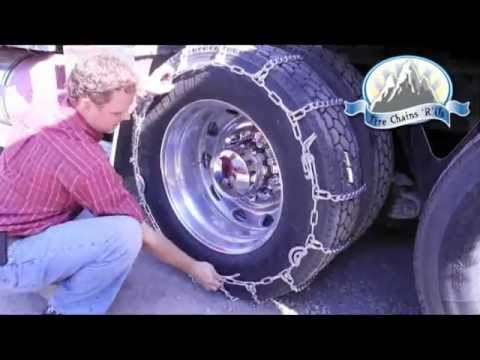 "
"
How can you select the right snow chains to meet vehicle requirements and help your family arrive safely?
“The right chains on your vehicle will make for a safer winter trip with improved traction, steering and braking,” said Troy Baumgartner, marketing director at Peerless Chain Company.
Peerless Chain Co. snow chains originated from diamond-shaped steel links that were woven between the spokes of a tire’s rim. Peerless supplied the Army with chains for combat vehicles during both World Wars.
Harry D. Weed of Canastota, New York invented snow chains in 1904 after seeing drivers wrap rope or vines around their tires to increase traction on snowy and muddy roads.
”Steel snow chains have evolved over the years into a variety of different materials and styles focused on improving traction, installation, vibration, wear, vehicle compatibility and overall safety,” Baumgartner said. “Some of these ’traction devices’ meet these criteria better than others depending upon on what the customer needs and is willing to pay for. ”
”
Traditionally, snow cables and chains consist of a “ladder” pattern, but more aggressive pattern choices, such as “Z” or “diamond”, are available as well and can provide improved performance.
Studs found on some traction devices further improve traction, but the use of these chains are restricted or even prohibited in some states.
The type of vehicle the traction device is destined for factors into the selection decision as well. The weight, size, make/model and tire/rim configuration of a vehicle will determine what type of traction device is best suited for use. Most traction device manufacturers provide convenient guides pointing to a few recommended choices eliminating the vast array of options.
Consider the following guidelines when selecting and using tire traction devices:
-Check with your state transportation department or highway patrol to learn the traction device requirements and restrictions for your area or the area in which you plan to travel in.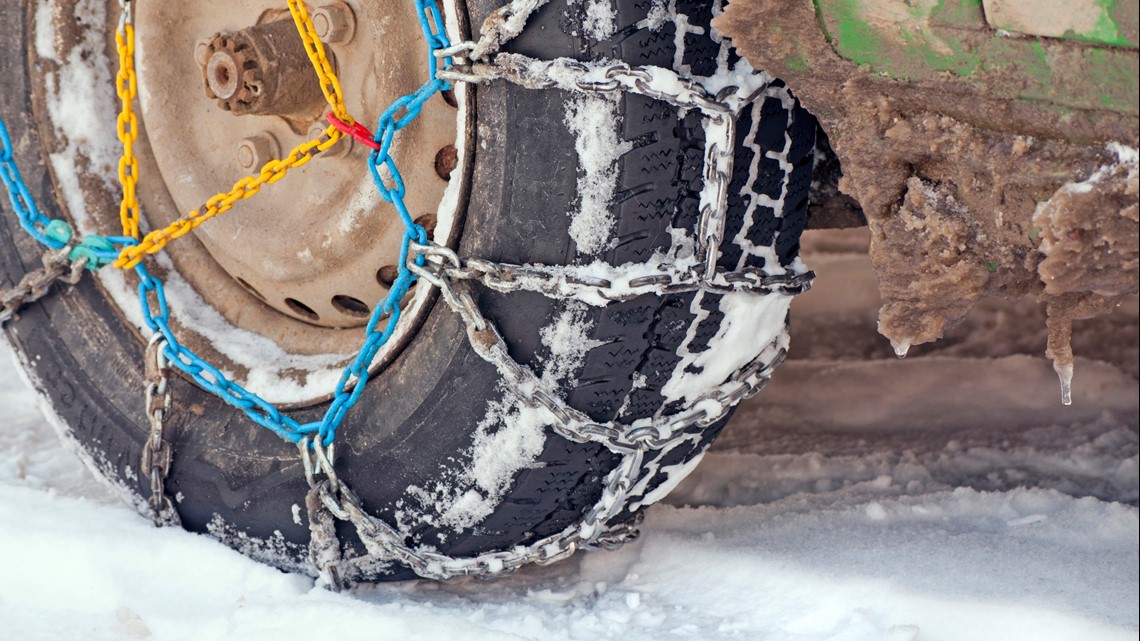
-Vehicle type, tire size, minimum clearances, etc. All cars, SUVs and trucks have varying tire sizes, minimum wheel-well clearances and special considerations pertaining to the vehicle’s traction control system and abs brakes. Always consult the vehicle owner manual for specifics before purchasing and using traction devices.
-Road conditions (i.e. icy, deep snow, steep grades or off-road).
-Frequency of use. All traction devices will wear with use, so determine the investment to make based on how often the device will be needed.
-Ride and comfort. All traction devices can cause noise and vibration but certain materials and patterns offer a more comfortable ride than others.
-Look for traction devices that install easily. Some have self-tightening features. Others require re-tightening by hand after driving a short distance.
-Install traction devices on all four wheels if possible; otherwise install them on the “drive” axle of your vehicle.
-Review manufacturer recommendations for speed limitations. All traction devices have limits and most are 35 mph or less.
-Inspect traction devices often and before use.
“Practice installing tire chains before you actually need them,” Baumgartner said. “It’s easier to learn how to put them on in good weather in your driveway than on the side of the road in a blizzard. Plus, please drive safely.”
01/21/2022 0
In winter, driving is more difficult than in the warmer months. Due to low temperatures, ice appears on the roads, snow drifts are possible. All this leads to an increase in the distance to a stop when braking, the maneuverability and controllability of the vehicle deteriorates. The solution to the problem is the use of special chains mounted on the wheels of a car.
Depending on the characteristics of the road, climatic conditions and the vehicle, chains with certain characteristics and configuration are selected.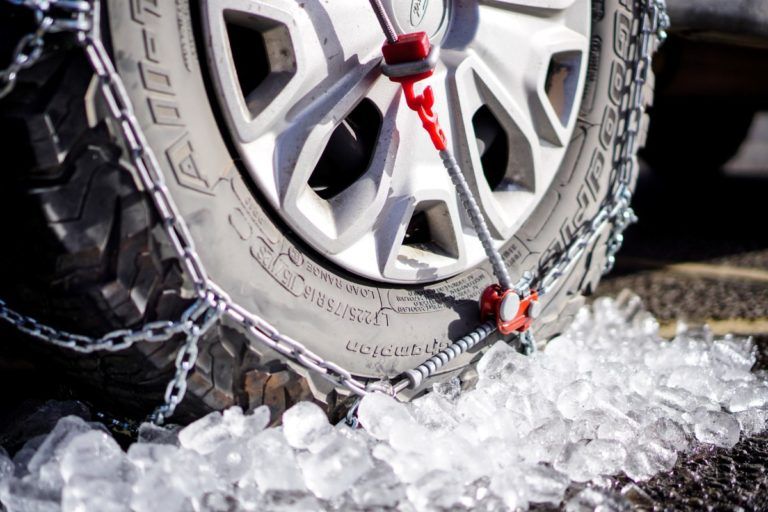 When buying, it is recommended to pay attention to the following factors:
When buying, it is recommended to pay attention to the following factors:
material and stiffness. For bad weather and ice, hard modifications are better, while plastic or rubber chains are suitable for driving in snow or mud.
Terms and features of operation. There are chains that are used only for difficult sections and are removed immediately after overcoming them. On sale are both such models and options for long trips that can be used for a long time and regularly.
Dimensions. There are options for both cars and trucks. For standard tire sizes, choosing a chain is not difficult.
Below are the highest quality, well-proven chain models for motorists. The rating also takes into account the financial affordability of products - the presented items are affordable, overly expensive options were not considered.
10. Taurus Diament 275 - for crossovers and SUVs, reinforced 16mm.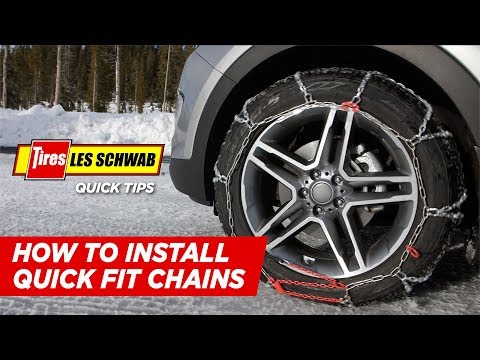 Seriously increase cross-country ability, all-weather. The kit includes two chains for the drive wheels. Easy to install and durable, but not suitable for ordinary cars.
Seriously increase cross-country ability, all-weather. The kit includes two chains for the drive wheels. Easy to install and durable, but not suitable for ordinary cars.
9. CarCommerce KN9-100. Inexpensive Polish chains with decent performance. Universal in application, for any passenger cars. Can be used in any season. The choice for those who have never used snow chains before.
8. Thule CG-10 060. "Golden mean" in terms of cost and quality. Automatic tensioning is provided without the need for tightening in the direction of travel. There are no difficulties during installation - detailed instructions are attached, functional elements are highlighted in color. For winter use only.
7. Konig ZIP Ultra. Italian chains that have proven themselves on winter snowy roads. Strong, resistant to wear, but not too easy to dismantle. Three-year warranty, automatic tensioning, minimum vibration are the advantages of these snow chains.
6. Pewag SXP 550 Snox PRO 88989. Austrian products. Easy to install, provide a secure grip on any ground. Reliable protection for tires and rims. The only drawback is that the cost is higher than other models from the list.
5.TM-SC-UNO1. Compact polyurethane studded chains for all-weather use, but only for difficult sections of the route. Designed for 12"-15" wheels. The speed limit is 40 kilometers per hour.
4. "Medved 76" - Russian chains for operation on difficult sections of the track. Consists of three identical elements, metal. Reliable fastening on a disk. Inexpensive, all-weather, but quite massive.
3. Tplus 4WD R16-R21. Metal, for wheels 16-21 inches. The design includes pads that protect the disc. Easy installation, light weight, affordable. Not suitable for long trips, speed limit is 40 km/h.
2. PRO-4x4 "Light". Expensive, high-quality chains with a convenient and reliable fastening system. Suitable for different types of rubber and rims. For passenger cars (vehicle weight limit - 1.3 tons).
Suitable for different types of rubber and rims. For passenger cars (vehicle weight limit - 1.3 tons).
1. Sorokin R13 28.4. Steel, easy to install even on a stuck car. The mass of the set is about 4 kilograms. They can even be used on trucks. Not suitable for long trips. The optimal solution in terms of cost, reliability, functionality and ease of operation.
Even professional driving skills are not always enough to cope with adverse weather and road conditions. A special technical solution is required - installation of snow chains on the wheels. They are made of metal, rubber or plastic elements, mounted on wheels, improve traction and vehicle handling.
Leave your review
I agree with the rules for processing personal data set out in the privacy policyCalculate the cost of chains
+
Please enable JavaScript to send a message. I agree with the rules for processing personal data set out in the privacy policy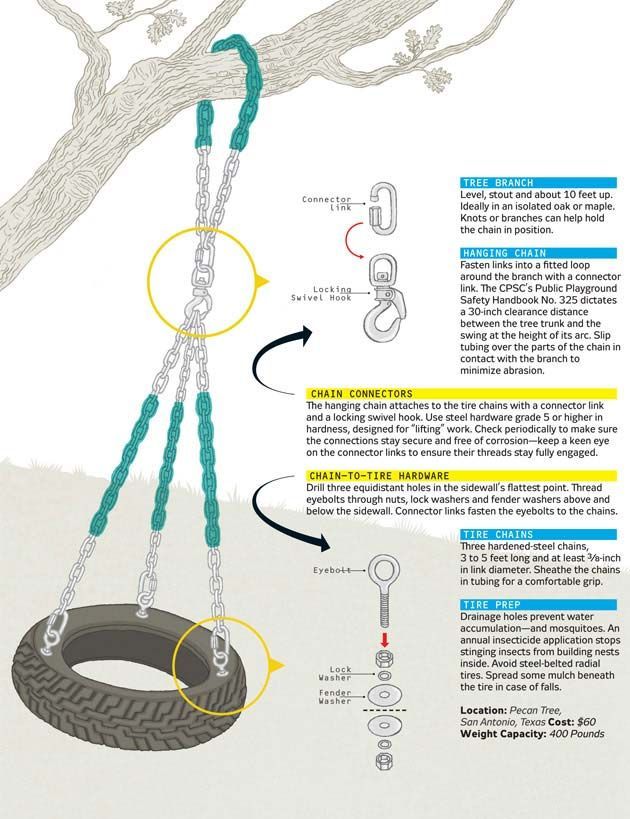 com.ua So, the car's handling improves in off-road or snowy areas. As a result, the risk of an emergency is minimized.
com.ua So, the car's handling improves in off-road or snowy areas. As a result, the risk of an emergency is minimized. Immediately pay attention to some disadvantages that must be taken into account before buying snow chains. With the constant use of such mechanisms, the tire tread wears out faster, the load on the transmission increases, and the driving speed is limited.
Chains are not meant to be used permanently, only temporarily if you need to overcome a difficult area.
Strictly adhere to the recommended speed: do not exceed the specified setting. Avoid hard braking and sharp turns. Do everything smoothly: do not immediately accelerate sharply. This will extend the life of your chains.
Monitor the tire pressure: if not enough, correct the situation with a compressor. If you feel that a failure has occurred and you need to repair the chain, then it is better to do it right away, otherwise there is a risk of damaging the wheel.
Let's look at the main types of designs that will help you choose the most suitable one in the future:
It is necessary to choose the type of devices depending on your desires and the tasks that you set for the chains.
Snow chains differ from each other depending on the material from which they are made. Focusing on this parameter, two classes can be distinguished:
 They wear out faster and will not improve the car's patency on icy areas in any way. Speed up to 80 km/h is allowed.
They wear out faster and will not improve the car's patency on icy areas in any way. Speed up to 80 km/h is allowed. It is also important to consider the frequency of use of the chains, which determines how quickly the tires will wear out.
Hard chains use hardened steel, a durable material that has the highest impact resistance. Sometimes such models are made of titanium, but they are already much more expensive.
Soft targets are available in plastic, rubber or polyurethane.
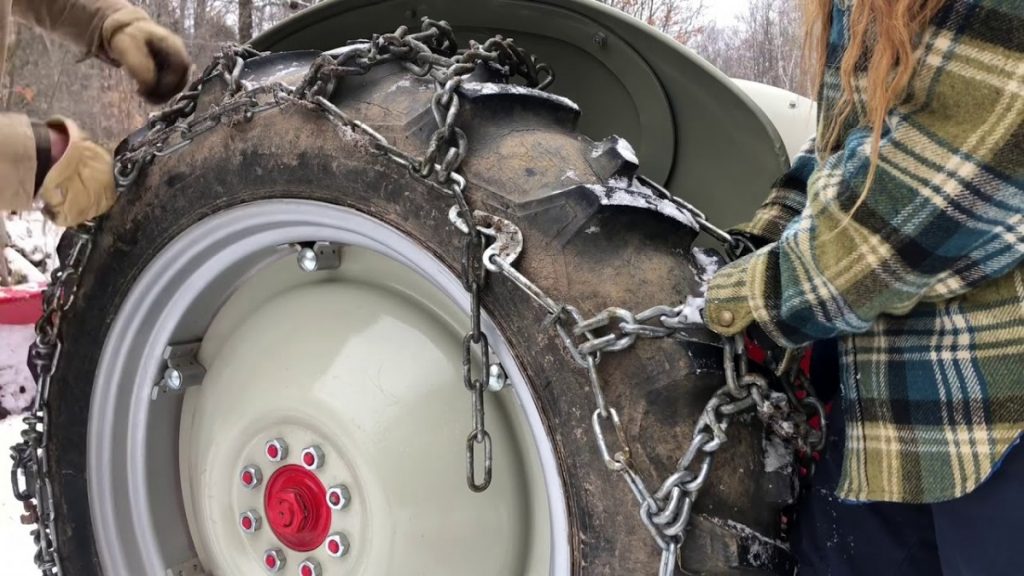 Ideal for trucks and other large vehicles.
Ideal for trucks and other large vehicles. Each of the options has its pros and cons, which one to choose depends on your preferences and desires.
These parameters determine the performance of the chains: the thicker they are, the more reliable and durable the design is. But even here there are nuances: a thick chain wears out the tire tread faster. Plus, it's harder to install. This option is definitely not suitable for cars that have a small wheel space.
For passenger cars and SUVs, structures with links in the range of 3.5-6 mm are used, for large vehicles - 6-19 mm.
Please note: if you plan to overcome snow-covered and muddy areas, it is better to choose chains for wheels with large links, for the passage of an icy road, structures with small links are used.
One of the main parameters for choosing snow chains is the width and diameter of the tire itself.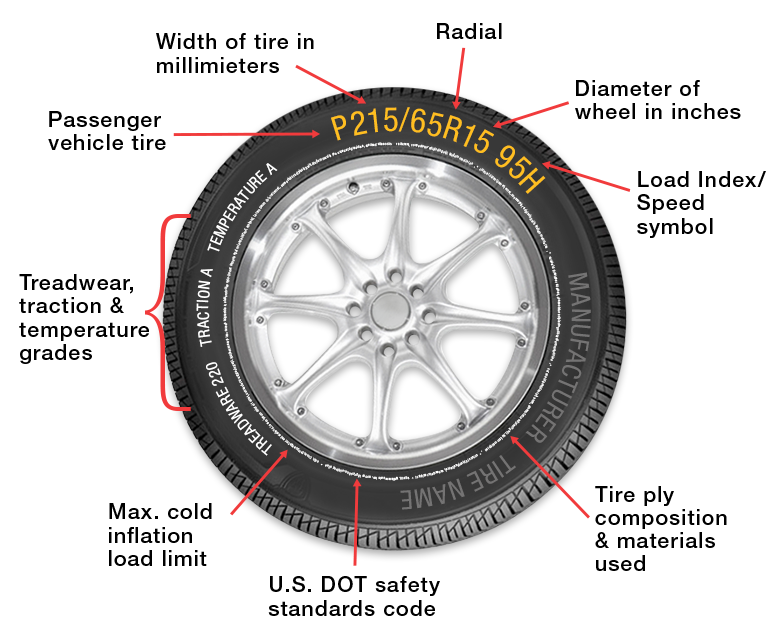 The manufacturer indicates on the packaging the size of the tire for which a particular model or special code is intended.
The manufacturer indicates on the packaging the size of the tire for which a particular model or special code is intended.
It is also important to consider the distance between the tire and the wheel arch. If you focus on this parameter, then here you can distinguish the following types of devices:
Snow chains are sold in different configurations: 2, 4 and 6 pieces. Most often they are mounted only on the drive axle - this is ideal for driving on "light" off-road or with rare use. The exception is all-wheel drive cars. If there are only 2 chains in a set, then install them only on the front axle. You can buy chains for wheels in Odessa, Kharkov and Kyiv at 130.com.ua with delivery in Ukraine.
TOP 3 snow chains
Looking for the best quality and best chains for wheels? This rating of wheel chains is compiled on the basis of such parameters as: high demand with positive feedback from our customers, high-quality manufacturing - no factory defects and service calls, as well as official warranty and post-warranty support in Ukraine.
Features:
Features:
Features:
